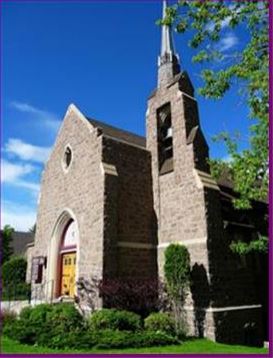St. Peter's Cathedral (Helena, Montana) facts for kids
Quick facts for kids St. Peter’s Cathedral |
|
|---|---|
| The Cathedral Church of Saint Peter | |

St. Peter's Episcopal Cathedral in Helena, Montana
|
|
| 46°35′33.03″N 112°02′23.23″W / 46.5925083°N 112.0397861°W | |
| Location | 511 N. Park Ave. Helena, Montana |
| Country | United States |
| Denomination | Episcopal Church |
| History | |
| Status | Cathedral |
| Founded | March 28, 1869 |
| Dedication | St Peter |
| Dedicated | March 27, 1932 |
| Architecture | |
| Functional status | Active |
| Architect(s) | Harold Whitehouse |
| Style | Gothic Revival |
| Groundbreaking | September 10, 1931 |
| Completed | 1932 |
| Construction cost | $90,000 |
| Specifications | |
| Materials | Stone |
| Administration | |
| Diocese | Montana |
| Province | Province 6 |
St. Peter's Cathedral is a beautiful church located in Helena, Montana, in the United States. It is the main church for the Episcopal Diocese of Montana. In 1990, the cathedral became a special part of the Helena Historic District. This means it is an important historical building. In 2020, the church had 499 members. About 133 people attended services each week.
Contents
History of St. Peter's Cathedral
How St. Peter's Church Began
The first Episcopal church services in Helena happened on August 11, 1867. Bishop Daniel Sylvester Tuttle and Reverend E. N. Goddard led these services. On March 28, 1869, Bishop Tuttle started a committee to create an Episcopal church in Helena. He held a special service called Holy Eucharist in the local courthouse.
Bishop Tuttle bought land on Warren and Grand Streets for $1,200 to build the first St. Peter's Church. This first church was made of stone and had a bell tower. It cost $12,000 to build. The first Holy Eucharist service in the new church was on October 19, 1879. The church was officially dedicated on November 11, 1881.
Building the New Cathedral
By 1920, Reverend Sidney Douglass Hooker was leading St. Peter's. He helped plan the new cathedral. People started raising money for the current church building in 1927. Harold Whitehouse, an architect from Spokane, Washington, designed the church. He designed it in the English country Gothic style. He also made a special cross for the church from myrtlewood.
The first stone for the new cathedral was placed by Bishop William F. Faber on September 10, 1931. The stones used to build the cathedral came from quarries near Helena. The new St. Peter's Church was finished for $90,000. Bishop Faber dedicated it on Easter Sunday, March 27, 1932. The bell and brass altar from the first church were moved to the new one.
Becoming a Cathedral
The new church was named the pro-cathedral for the diocese. This means it was a temporary main church. In 1941, a house for the dean (a church leader) was built next to the cathedral. This house is now the Diocesan Offices and is also a historic building. St. Peter's stopped being a cathedral in the mid-1990s. However, it became a cathedral again in 2004.
What's Happening Now at St. Peter's
St. Peter's was a pro-cathedral until the mid-1990s. Then it became a regular parish church. In 2004, it was once again named a cathedral. Other buildings on the church property include the deanery, built in 1941. This building now serves as the Bishop's Office. Wilson Hall, an education building, was completed in 1959.
St. Peter's Cathedral is home to the Togendowagon Society. This is a special Native American ministry. Togendowagon means 'awakening'. Father Ray Brown leads services with drums. They also use sweet grass and sage as offerings. These services happen on the second and fourth Saturdays of each month. They do not happen in July and August because of powwow season.
The cathedral stands across the street from the Olsen House.
See also

